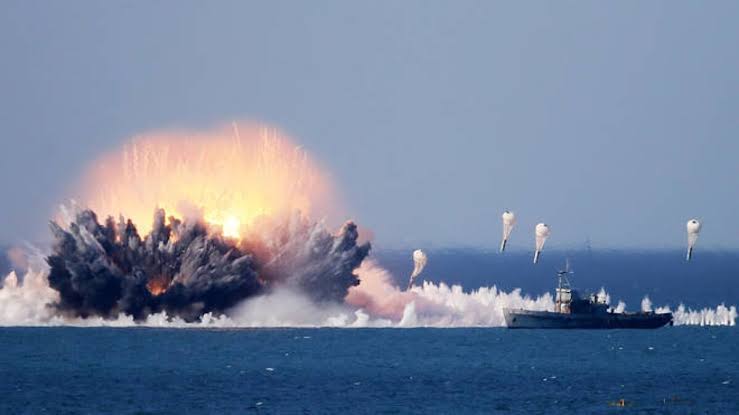An Era of Industrial Conflict: The 21st-century war stands as a testament to the evolution of long prolonged warfare, characterised by the fusion of industrial might, and strategic manoeuvring. The notion of victory remains ambiguous with information warfare scripting history. Thus both the strategic contest of will and war endurance dictate the strategic exhaustion. These conflicts swiftly transition from kinetic engagements to a protracted struggle defined by industrial attrition and strategic calculus. Against a backdrop of strategic imperatives and tactical exigencies, nations will confront the spectre of strategic exhaustion and operational setbacks. The path forward demands strategic ingenuity, industrial resilience, and unwavering resolve.
The targeting philosophy has recognised the futility of conventional warfare and embraced the paradigm of industrial attrition. Proxy wars and assistance mark again a limit to material support impacting the war economy, setting the stage for a prolonged conflict marked by resource depletion and strategic manoeuvring.
The Ukraine-Russia and Israel-Hamas war has become a war of attrition imposing enormous costs on both sides, but over time, it will favour the nation with an indigenous defence-industrial base and strategic will. The need is to replace its equipment faster than the adversary and target its will and capability to sustain a prolonged war effort. It also highlights the need to shift from the force-on-force attrition model to a manoeuvre model targeting critical vulnerabilities and dislocating the adversary physically, functionally, temporarily and morally. There can be no decisive outcome in a war of attrition, but strategic exhaustion and dwindling war stamina could turn the tide.
War stamina refers to the sustained ability of a military force to engage in prolonged conflict without experiencing debilitating exhaustion or dependence on external sources. War exhaustion is a state of public and political disillusion or depression disapproving of the continuation of a prolonged conflict due to the miseries ravaged by war. It has physical, economic, political, and psychological content attached to it
Understanding War Stamina and Exhaustion
War stamina refers to the sustained ability of a military force to engage in prolonged conflict without experiencing debilitating exhaustion or dependence on external sources which remain unpredictable and denuding with passage of time.
War exhaustion is a state of public and political disillusion or depression disapproving of the continuation of a prolonged conflict due to the miseries ravaged by war. It has physical, economic, political, and psychological content attached to it.
War Stamina embodies operational and logistic resilience, troop morale, societal resilience, indigenous defence capacity and economic resources. War exhaustion occurs when the resources and will of a fighting force fall to such a level that it is incapable of sustaining effective combat operations.

Complexities Impacting War Stamina
Technology Manifestation: The 21st century has witnessed technological changes and disruption in all sectors as the norm today. Possibly the most disruptive changes have been driven by the emergent technology and proliferation of advanced weaponry signalling the intensification of the pace and attendant destruction even beyond the war zone. Wars have transited society and people and impacted their long-term livelihood leading to despair and delusion. The destruction of critical infrastructure, and industrial complexes and the disruption of the supply chain by precision warfare has added a new dimension.
Psychological and Societal Dimensions: Warfare not only impacts physical resources but also takes a toll on the emotional and psychological mindsets of both soldiers and civilians. The exposure to the gory side of war – violence and trauma, affects the mental frame impacting both the will and morale of the nation. Post-traumatic stress disorder (PTSD) is identified as the most common among military personnel and populations that find themselves in conflict-related situations. PTSD is followed by anxiety disorders and depression. This is exuberated by fallouts of displacement, humanitarian crisis and loss of livelihood impacting communities.
A resilient supply chain plays a crucial role in ensuring timely supplies to support the battlefront. It must be flexible, timely, adaptive and responsive to support the desired war effort, minimising downtime and optimising operational effectiveness. Multiple redundancies will need to be built as these supply chains present critical vulnerabilities to the adversary
Impact on the Economy: War economy has the largest and most prolonged impact. War drains the economy due to the military cost and post-war reconstruction costs. Protracted conflicts bleed national budgets at the cost of the socio-economic development of a nation. In a globalised world of geo-economics, the ripples of war are felt far and wide like the food and energy shortage due to the Russia-Ukraine war.
Enhancing War Resilience
Resilient Defence Industry: A sound defence ecosystem and indigenous industrial base is critical to a nation’s military might, providing the essential capacity, capability and technology for war endurance. It must have a surge capability as well as a long-term sustained capacity to deliver military ware at the desired pace and quantity. It must foster a culture of innovation, technology prowess and production efficiency in manufacturing. Besides efficient supply chain management is equally critical. Flexible and adaptive production lines with a skilled and motivated workforce will enhance capacities with minimum disruptions. The need is to draw a fine balance of raw materials held as reserves and assured supply chains to scale up requirements. Diversification of defence supplies will enhance redundancy mitigating supply chain vulnerabilities.

Vibrant Supply Chain: A resilient supply chain plays a crucial role in ensuring timely supplies to support the battlefront. It must be flexible, timely, adaptive and responsive to support the desired war effort, minimising downtime and optimising operational effectiveness. Multiple redundancies will need to be built as these supply chains present critical vulnerabilities to the adversary. Leveraging advanced technologies like AI, autonomous systems, and real-time monitoring enhances the agility and responsiveness of logistics trains, enabling combat efficiency and readiness.
Strategies for Mitigating War Exhaustion
- Investment in Infrastructure: Developing a sound defence ecosystem requires sufficient budgeting and policy support. Governments invest in critical infrastructure, manufacturing facilities, transportation networks, and strategic storage facilities, to enhance the redundancy and capacity of the defence industry and supply chain.
- Capacity Building: The defence industry must invest in enhancing reserve capabilities, expanding production output, and diversifying supply chains to sustain the war effort.
- Risk-Vulnerability Management: Contingency planning and risk management practices, including supply chain mapping, and vulnerability minimisation, will enable minimum disruptions and maximum efficiency.
- Technological Integration: Technological solutions such as additive manufacturing, blockchain, and artificial intelligence can revolutionise defence manufacturing and logistics, enhancing efficiency, reducing costs, and improving resilience.
- Training: Training is equally important to minimise own casualties to men and material as also target the enemy’s key vulnerabilities. Manoeuvre warfare doctrines must be the driver at the operational level rather than attrition-oriented mindsets of leadership.
- Psychological Resilience: War impacts the body, mind and soul. Mental health programmes and psychosocial support networks are important for mitigating the psychological impact of war on soldiers and civilians. Promoting resilience and coping strategies like trauma care can promote recovery and rehabilitation.
Developing a sound defence ecosystem requires sufficient budgeting and policy support. Governments invest in critical infrastructure, manufacturing facilities, transportation networks, and strategic storage facilities, to enhance the redundancy and capacity of the defence industry and supply chain. The defence industry must invest in enhancing reserve capabilities, expanding production output, and diversifying supply chains to sustain the war effort
Conclusion
The 21st-century wars have unfolded the distinctive challenges that are increasingly resulting in depleting war stamina leading to war exhaustion. These multidomain wars are impacting both resources and will at an unprecedented pace blurring the lines between traditional and asymmetric warfare, and kinetic and non-kinetic warfare. Nations must review their war strategies and indigenous defence capacities to endure and prevail in future wars. The need is for innovative approaches to sustain long-term operational effectiveness and mitigate war exhaustion.
-The author is a PVSM, AVSM, VSM has had an illustrious career spanning nearly four decades. A distinguished Armoured Corps officer, he has served in various prestigious staff and command appointments including Commander Independent Armoured Brigade, ADG PP, GOC Armoured Division and GOC Strike 1. The officer retired as DG Mechanised Forces in December 2017 during which he was the architect to initiate process for reintroduction of Light Tank and Chairman on the study on C5ISR for Indian Army. Subsequently he was Consultant MoD/OFB from 2018 to 2020. The Officer is a reputed defence analyst, a motivational speaker and prolific writer on matters of military, defence technology and national security.The views expressed are personal and do not necessarily carry the views of Raksha Anirveda
The author, a PVSM, AVSM, VSM has had an illustrious career spanning nearly four decades. A distinguished Armoured Corps officer, he has served in various prestigious staff and command appointments including Commander Independent Armoured Brigade, ADG PP, GOC Armoured Division and GOC Strike 1. The officer retired as DG Mechanised Forces in December 2017 during which he was the architect to initiate process for reintroduction of Light Tank and Chairman on the study on C5ISR for Indian Army. Subsequently he was Consultant MoD/OFB from 2018 to 2020. He is also a reputed defence analyst, a motivational speaker and prolific writer on matters of military, defence technology and national security. The views expressed are personal and do not necessarily carry the views of Raksha Anirveda






